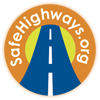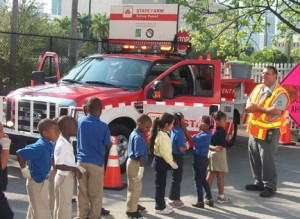Promotion, Publicity and Public Understanding
A look at how Safety Service Patrols reach the public through media networks
One of the benefits highlighted by state departments of transportation and turnpike authorities currently involved in Safety Service Patrol sponsorship programs is heightened publicity and visibility of their patrol. As expected, with a recognized company’s name attached like Commerce Insurance, State Farm Insurance or CVS Pharmacy, the press often pays closer, and in some cases more attention, to public transportation programs linked to the private sector’s big names, and for that matter, often times so does the public. But it is important for all Safety Service Patrols, sponsored or not, to be recognizable to the public. One way to reach this audience, other than patrolling the roadways, is through promotion of Safety Service Patrols in the press, on social media networks and at local, community events.
Promotion through local news networks can often be difficult. With so many news stories coming in, media outlets often need a story to be “newsworthy” before going to print or broadcast. Safety Service Patrol centric press releases often focus on increased (or decreased) coverage areas and service hours. But these changes in patrols are not a regular occurrence and usually only provide a one time news story.
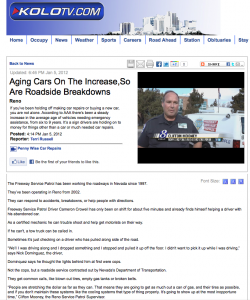 On-going opportunities for positive press also exist. Expected high traffic volumes before holiday weekends on Florida’s Turnpike provided a chance for the State Farm Safety Patrol to make the news, reminding motorists that the patrol would be available to motorists who found themselves stranded along the roadway during high traffic times. Recently, the Nevada DOT’s Freeway Service Patrol made the news when noting an increase in stranded motorists with aging cars breaking down on the side of the road so the DOT took the opportunity to remind motorists of the FSP’s presence.
On-going opportunities for positive press also exist. Expected high traffic volumes before holiday weekends on Florida’s Turnpike provided a chance for the State Farm Safety Patrol to make the news, reminding motorists that the patrol would be available to motorists who found themselves stranded along the roadway during high traffic times. Recently, the Nevada DOT’s Freeway Service Patrol made the news when noting an increase in stranded motorists with aging cars breaking down on the side of the road so the DOT took the opportunity to remind motorists of the FSP’s presence.
Additionally, Safety Service Patrol program operators are often the perfect spokespeople for public service announcements about rules of the road for motorists that help to increase the safety of first responders like SSPs as well as motorists themselves. In Georgia, for example, it was the GDOT HERO Patrol operators who were featured as spokespeople for the “Move Over Law” in a recent news article that reminded motorists of the importance of moving over for first responders on the side of the road. And in New York, an annual press event that was held to remind motorists to use safety belts, featured the NYSDOT HELP patrol in 2011.
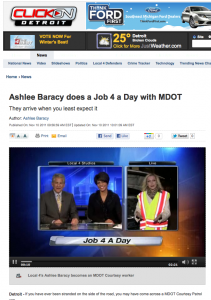 Finally, with the increase in viewer’s responsiveness to reality television and a public interest in getting to know what different professions entail, there is potential for a “day in the life” story on Safety Service Patrol operators. Most recently, the Michigan DOT’s Freeway Courtesy Patrol was featured on a local news network’s “Job 4 a Day” segment. The segment featured a ride-a-long with one of the Patrol’s operators and took viewers through the important tasks associated with the job and explained the relationship between motorists and the Freeway Courtesy Patrol.
Finally, with the increase in viewer’s responsiveness to reality television and a public interest in getting to know what different professions entail, there is potential for a “day in the life” story on Safety Service Patrol operators. Most recently, the Michigan DOT’s Freeway Courtesy Patrol was featured on a local news network’s “Job 4 a Day” segment. The segment featured a ride-a-long with one of the Patrol’s operators and took viewers through the important tasks associated with the job and explained the relationship between motorists and the Freeway Courtesy Patrol.
Another great opportunity to reach the public is via social media networks like Facebook and Twitter. The public is already signed up, logging-in and updating these social savvy sites and always looking for the latest news to share with their “friends” and “followers,” making them an ideal audience to reach. The Miami Dade Expressway Authority Road Rangers have already started to take advantage of this audience with their Facebook page. The MDX Road Rangers page has 258 ”likes” and shares assisted motorists’ comments and news on the patrol with its “friends.”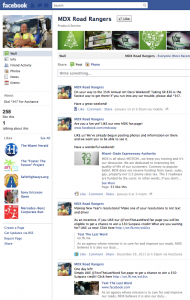
In addition, many state authorities currently have Twitter accounts that allow them to update followers with traffic alerts and information on new construction zones. These Twitter accounts are the perfect chance for state authorities to promote Safety Service Patrols, reaching new audiences and reminding existing audiences of the great benefit of these programs. It also gives state departments the opportunity to get involved in the conversation of Safety Service Patrols with motorists who have already received assistance and are tweeting about their experiences. Whether a simple “retweet” or an “@user” response to a tweet, Twitter allows Safety Service Patrols to get involved in the dialogue already present on the social network.
For SSP’s looking to get more involved with the public and the communities they serve, participating at local events is an effective way to reach their audience and inform them of the great service they provide. Participating in a town parade, or a simple truck set up in the background of a local event, with a driver’s presence to answer questions, helps to make the patrols more recognizable. In many jurisdictions “Touch a Truck” events are held to give the community the chance to get to know a variety of emergency responder vehicles, including police vehicles, ambulances, fire trucks and Safety Service Patrol vehicles.
Patrols in Georgia and Florida have also benefited by becoming involved in the local school systems. SSP drivers in both states go to schools to inform students about the services they provide, allow students to explore the vehicles and answer any questions the students may have about the work they do. The GDOT HERO Patrol invites local schools to contact them directly online to schedule an event at their school.
A combination of press, social media and community presence for SSPs helps to increase public awareness of the patrols and their services. While these efforts may take some time to develop, a patrol specific section on a state department’s webpage can also serve to educate assisted motorists of the service they have just received. The overall goal is to increase public understanding of the role of patrols with greater understanding leading to improved highway safety. Patrol operators can spend more time attending to incidents and accidents and less time explaining their mission. Recognizing and appreciating the role of the patrol improves compliance with move over laws and increases driving public’s comfort, knowing they are not alone on our nation’s highways.
